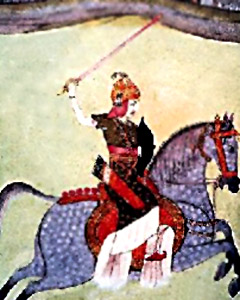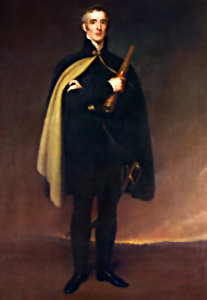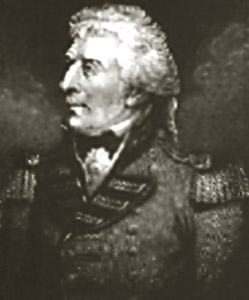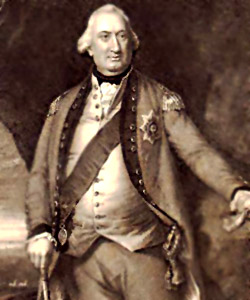 The vaulting ambition of Raghunathrao, Peshwa Baji Rao II`s father and the latter`s own incompetence since his ascension to the throne, had long caused much conspiracy within the Maratha confederacy. Peshwa Baji Rao II no longer commanded the reverence his predecessors had. In October 1802, Baji Rao II was defeated by the Holkar ruler of Indore in the Battle of Poona (Pune). He fled to British safety. Then, in December of the same year, Baji Rao II concluded the Treaty of Bassein with the British East India Company. The treaty relinquished territory for the upholding of an auxiliary force and also agreed to treat in a powerless mode. The British also had to hold back the French influence into India.
The vaulting ambition of Raghunathrao, Peshwa Baji Rao II`s father and the latter`s own incompetence since his ascension to the throne, had long caused much conspiracy within the Maratha confederacy. Peshwa Baji Rao II no longer commanded the reverence his predecessors had. In October 1802, Baji Rao II was defeated by the Holkar ruler of Indore in the Battle of Poona (Pune). He fled to British safety. Then, in December of the same year, Baji Rao II concluded the Treaty of Bassein with the British East India Company. The treaty relinquished territory for the upholding of an auxiliary force and also agreed to treat in a powerless mode. The British also had to hold back the French influence into India.
This act on the part of the Peshwa, their titular overlord, horrified and sickened the Maratha chieftains. In particular, the Sindhia rulers of Gwalior and the Bhonsle rulers of Nagpur and Berar tremendously challenged the agreement. The Holkar rulers of Indore joined the conflict belatedly and coerced the British to make peace. And thus began the saga of the Second Maratha War.
In February 1803, Major-General Arthur Wellesley gathered and organised his forces in Seringapatam (present day Srirangapatnam, Karnataka), as the Maratha threat of conflict grew larger.
On 13th May, Wellesley`s forces escorted Baji Rao II to Poona (present day Pune, Maharashtra). The troops of Holkar withdrew on Wellesley`s advance and thus avoided a battle with the British.
In August 1803, as Wellesley approached the renewal of war with the Marathas, he the following goals:

• Destruction of the French presence on the banks of the Jumna (present day Yamuna River)
• Extend the Company`s frontier to the line of the Jumna (present day Yamuna River) and to include possession of Delhi and Agra
• Take control of the person of the Mughal Emperor
• Construct a system of alliances with the states of Rajputana
• Annex Bundelkhand
From the period starting from August 1803 and ending in February 1804, Sir Wellesley waged the Deccan Campaign to win over the Se3cond Maratha War. On 12th August 1803, Major-General Arthur Wellesley captured Ahmednagar, taking a major supply depot from the Marathas and securing British lines of communication with Poona (Pune). In consequence, this forced the Marathas to strike at Hyderabad.
On 23rd September, with a force of 4500, the British swept a total victoryin Assaye over the 10,500 Maratha forces, led by Sindia. The British suffered 1566 killed and wounded and the Marathas approximately 6000. Wellesley encountered some criticism for dividing his forces which was viewed as a contributing factor to his high number of casualties. On 15th October 1803, Colonel Stevenson took possession of Burhanpur without opposition.
Victory for the English in the Second Maratha war was heightened even more, when on 21st October, the British accepted the surrender of the fortress at Asirgarh. This implied that Sindia had lost his last possession in the Deccan. On 29th November, Wellesley defeated Bhonsle`s army of nearly 40,000 at Argaum, while suffering only 360 British casualties. Maratha casualties numbered approximately 5000.
On 15th December, the forces of Wellesley and Stevenson assaulted and captured Bhonsle`s fortress, suffering only 126 casualties to perhaps 4000 for the Marathas. Thus the last fortified position along the infiltration route linking the Deccan to Hindustan, or north India had fallen to the British. On 17th December, the British concluded the Treaty of Deogaon with the Raja of Berar. He relinquished to the British the province of Cuttack including Balasore and all territory west of the river Warda.
On 30th December, Sindia agreed to the Treaty of Surji Arjangaon, by which he ceded to the British all land lying between the Jumna (Yamuna River) and the Ganga River and all forts and territories north of Jaipur, Jodhpur and Gohud. In the west, the British seized Broach and Ahmednagar and all territory south of the Ajanta Hills. This treaty covered the results of campaigns of both Wellesley and Lord Lake (1744-1808).
In February 1804, Sir John Malcolm (1764-1833) negotiated a subsidiary alliance with Sindia, placing a defence force of 6000 infantry with associated cavalry and artillery on the Maratha frontier.
The second phase of the Second Maratha War constituted of the Northern Campaign, stretching from August 1803 to February 1805. As the Anglo-Maratha War loomed, the British made great effort to turn the British and French officers in the employment of Sindia. The defecting officers were handsomely paid under the terms of Lake`s Proclamation of August 29. In consequence, the Marathas went to war, stripped of much of their senior command structure.
 On 29th August, the city of Broach in Gujarat fell to the British.
On 29th August, the city of Broach in Gujarat fell to the British.
On 4th September 1803, Lord Lake captured the fort at Aligarh which had served the French as a major depot. Maratha casualties numbered 2000, with 281 pieces of artillery captured by the British. On 11th September, Lake defeated Louis Bourquin in the Battle of Delhi and took tacit control of Shah Alam II, the aged Mughal Emperor. The British lost 478 killed or missing and the Marathas had an estimated 4500 killed.
The port of Cuttack in Orissa fell to the British 18 September, as did the city of Balasore.
On 18th October, after a short siege, the British took control of Agra, capturing between 5000 and 6000 Marathas and a huge storehouse of goods and treasure. The capture of the fort gave to the British the strategic controlling point of north India.
On 1st November in Laswari, Lord Lake defeated a force of seventeen battalions led by the French Commander, Colonel Dudrenec. British casualties numbered slightly over 800, in what was evaluated later as a difficult close run victory. The Marathas lost approximately 7000 killed and 71 pieces of artillery.
Although the Nizam of Hyderabad as an ally generally failed to deliver any assistance in 1804, the British offered to the Nizam some of the territory of the Raja of Berar. To Peshwa Baji Rao II, the British assigned the fort and district of Ahmednagar. In other settlements, the British signed treaties of alliance with the Rajas of Jodhpur, Jaipur, Macheri, Bundi, and the Jat ruler of Bharatpur.
The Holkar Campaign was waged by the British in the ensuing Second Maratha War, within the years of 1804-05
 On 16th April 1804, Wellesley ordered Lord Lake to commence hostilities against Holkar (1776-1811). By April 23, Lake had forced Holkar to retreat to Kota and then further south on the approach of addition British forces. In June, due to the monsoon rains, Lake took his main force into encampment at Cawnpore (presently Kanpur, Uttar Pradesh).
On 16th April 1804, Wellesley ordered Lord Lake to commence hostilities against Holkar (1776-1811). By April 23, Lake had forced Holkar to retreat to Kota and then further south on the approach of addition British forces. In June, due to the monsoon rains, Lake took his main force into encampment at Cawnpore (presently Kanpur, Uttar Pradesh).
On 8th July, Colonel William Monson (1760-1807) infiltrated beyond the Mokundra Pass deep into Holkar`s territory without appropriate support. At this point, Monson determined that his retreat was necessary which continued until his arrival at Agra on August 31, essentially as an exhausted force. Holkar held Delhi from 8-28 October in siege, until he was fought off and Delhi was relieved by Lake`s forces. Holkar subsequently decamped to raid the Doab.
Lord Lake finally was successful to defeat Holkar in Farruckkabad on 17th November, after a brilliant forced march from the Doab. On 24th December, the fortress at Dig fell to the British.
Within the period of 9th January to 21st February 1805, Lord Lake assaulted the fortress at Bharatpur unsuccessfully, suffering a high loss of men. Unaccountably, he had failed to make a proper breach of the walls prior to the assault. British losses numbered 100 officers and 3100 men.
On 23rd November 1805, the Company signed a peace treaty with Sindia. Its terms included: expiration of the defensive alliance, restoration of Gwalior and Gohud to the Marathas, the avoidance of British treaties with the Rajput chieftain and the return of specific portions of land. The Company passed a measure supporting the establishment of an East India College as a substitute for Fort William College at Calcutta. Thus, the Second Maratha War was brought to a close, with efforts being put by the East India Company.
In July 1805, Lord Wellesley resigned the post of Governor-General in the face of severe criticism. He perceived the likelihood of being recalled. He left Calcutta for England on August 5, 1805.
On 30th July 1805, Lord Charles Cornwallis (1738-1805) received reappointment to the duties of Governor-General of India. Barely two months later he died while on tour at Ghazipur on October 5. Sir George Barlow (1762-1846) served as Acting Governor-General until 1807.



















